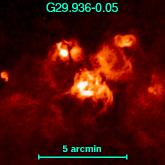

Tables 3-6 give the 20 cm and 6 cm catalogs. They are divided into sources brighter than 5.5 times the map rms and sources between 5 and 5.5 sigma. The faint source catalogs are heavily contaminated (perhaps even dominated) by spurious sidelobes. We recommend their use only when the catalogs are being matched to another catalog, when the requirement of a coincidence can be used to confidently identify real sources.
The files are all in gzipped ascii format:
Table 3: 20 cm sources with Sp>5.5 sigma
Table 4: 20 cm sources with Sp<5.5 sigma
Table 5: 6 cm sources with Sp>5.5 sigma
Table 6: 6 cm sources with Sp<5.5 sigma
The coverage maps giving the rms noise as a function of Galactic coordinates are also available. They can be used to determine whether a particular position was included in the survey and to find the rms detection limit when no source is found. These are in FITS image format:
20cm FITS coverage map [9.3 Mb]
6cm FITS coverage map [3.2 Mb]
Note: This version of the catalogs was released on 2007 March 21. To construct them, the images were coadded again to correct an error in the astrometry that could cause sources to be shifted by up to one pixel (1 to 1.5 arcseconds.) Most sources have smaller shifts, and many are hardly shifted at all. For the 20 cm catalog, the median position shift is 0.15 arcsec, and only 5% of sources are shifted by more than 1 arcsec. Where differences in positions exist, the new catalog is more accurate. For most uses the changes in the catalog are small.
As a result of small accompanying changes in peak flux densities, some sources in the previous catalog dropped below the detection threshold and do not appear in the new version (and vice versa.) This leads to changes in the source lists for each catalog at the detection limit.
We recommend the new catalogs for all new projects, but the old catalogs are still available for ongoing projects (Table 3 Table 4 Table 5 Table 6). The formats of the new and old versions are identical.
| Column | Description | |
|---|---|---|
| 1 | ... | Source name lll.lll+b.bbb from Galactic longitude and latitude (degrees). |
| 2-7 | ... | Right ascension and declination (J2000). |
| 8 | ... | Estimated probability that the object is a sidelobe (in which case it is spurious). |
| 9-10 | ... | Source peak and integrated flux densities (mJy) from a Gaussian fit. |
| 11 | ... | Computed map rms (mJy) at the source position. |
| 12-14 | ... | Deconvolved major and minor axes (FWHM, arcsec) and position angle (degrees east of north) from the Gaussian fit. |
| 15 | ... | Name of field from which source was extracted. |
| 16 | ... | Flag with 'o' indicating sources found in the old (1990-1994) catalogs constructed from these observations and 'OH' marking objects that are not continuum sources but instead are detected through their 1611 MHz OH maser emission (Becker, White & Proctor 1992). |
| Column | Description | |
|---|---|---|
| 1 | ... | Source name lll.lll+b.bbb from Galactic longitude and latitude (degrees). |
| 2-7 | ... | Right ascension and declination (J2000). |
| 8 | ... | Estimated probability that the 6 cm source is a sidelobe (in which case it is spurious). Blank if this source is detected only at 20 cm or (for four of the sources) if it is detected at less than 5.5-sigma significance at 6 cm. |
| 9-10 | ... | 6 cm source peak and integrated flux densities (mJy) from a Gaussian fit. |
| 11 | ... | Computed 6 cm map rms (mJy) at the source position. |
| 12-14 | ... | Deconvolved 6 cm major and minor axes (FWHM, arcsec) and position angle (degrees east of north) from the Gaussian fit. |
| 15 | ... | Estimated probability that the 20 cm source is a sidelobe (in which case it is spurious). Blank if this source is detected only at 6 cm or (for 27 sources) if it is detected at less than 5.5-sigma significance at 20 cm. |
| 16-17 | ... | 20 cm source peak and integrated flux densities (mJy) from a Gaussian fit. |
| 18 | ... | Computed 20 cm map rms (mJy) at the source position. |
| 19 | ... | Name of field from which source was extracted. |
| 20 | ... | Flag with 'c' indicating sources found in the old 6 cm catalog, 'l' indicating sources in the old 20 cm catalog, and 'cl' indicating sources found in both old catalogs. 'OH' marks 20 cm objects that are not continuum sources but instead are detected through their 1611 MHz OH maser emission (Becker, White & Proctor 1992). '*' marks 20 cm-only sources very close to the 6 cm survey edge. |